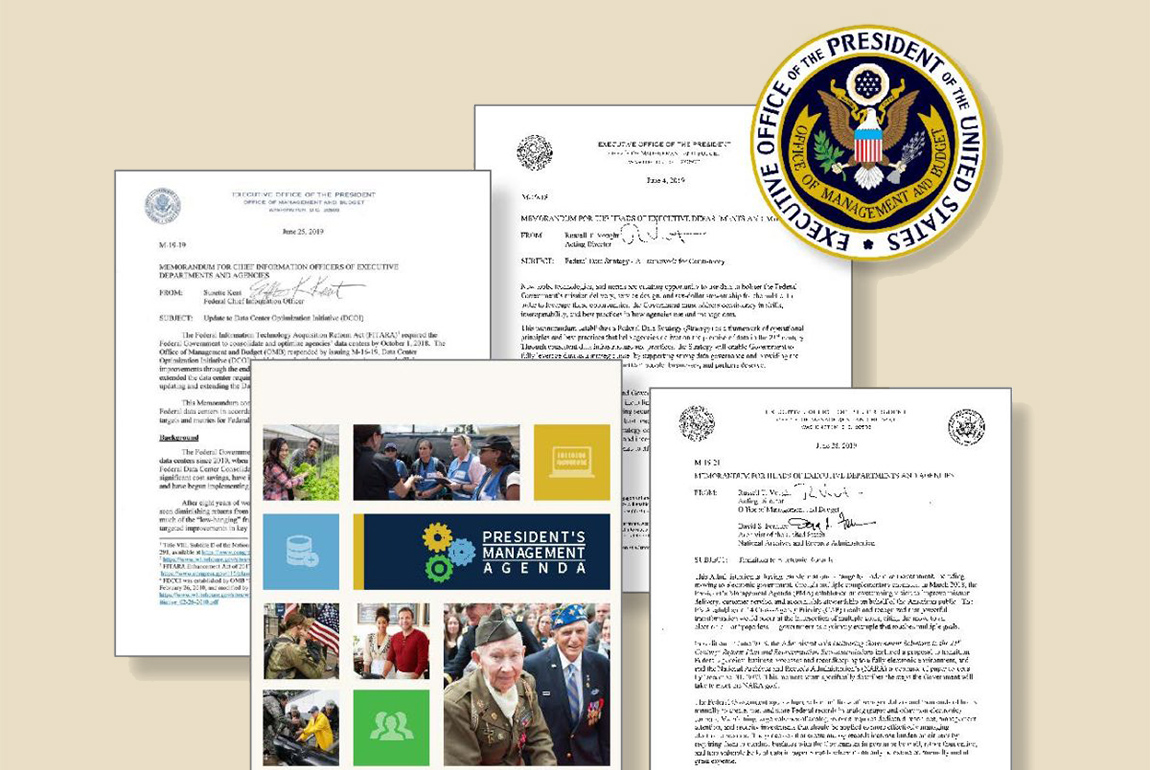

In June, the Office of Management and Budget (OMB) issued a set of information technology-related memoranda to department and agency leadership: “Transition to Electronic Records” (M-19-21, June 28, 2019), “Update to Data Center Optimization Initiative” (M-19- 19, June 25, 2019), and “Federal Data Strategy – A Framework for Consistency” (M-19-18, June 4, 2019). The policy guidance all work towards executing the “modern information technology” and the “data, accountability, and transparency” components of the President’s Management Agenda.
TRANSITION TO ELECTRONIC RECORDS
A major White House government reform and modernization priority is moving to a fully electronic recordkeeping environment by December 31, 2022 – a “paperless” government. By that point, the National Archives and Records Administration (NARA) will no longer accept paper records. The Transition to Electronic Records memorandum directs agencies to:
1) “Ensure that all Federal records are created, retained, and managed in electronic formats, with appropriate metadata, and
2) Develop plans to close agency-operated storage facilities for paper and other analog records, and transfer those records to Federal Records Centers operated by NARA or commercial storage facilities.”
Agencies should meet the recordkeeping requirement for permanent electronic records by the end of this calendar year. All permanent and temporary records – electronic or analog – must meet the December 31, 2022 deadline. Storage facilities must be closed by the end of calendar year 2022. OMB directs NARA to issue supporting electronic recordkeeping guidance to agencies by September 30, 2020.
UPDATE TO DATA CENTER OPTIMIZATION INITIATIVE
OMB guidance updates and aligns the Administration’s Data Center Optimization Initiative (DCOI) to the Management Agenda. Federal efforts to consolidate and optimize department and agency data centers began in 2010 under the then-Federal Data Center Consolidation Initiative (FDCCI). The Federal Information Technology Acquisition Reform Act (FITARA) required consolidation by October 1, 2018. That deadline was later extended to October 1, 2020.
OMB requires all 24 CFO Act agencies (including the Department of Defense) to report annually on 1) the comprehensive inventory of data centers owned, operated, or maintained by or on behalf of the agency and 2) the multi-year strategy to achieve consolidation and optimization. Agencies are directed to provide quarterly updates on progress, performance metrics, and cost savings achieved through consolidation. OMB updates, clarifies, and removes several of the performance metrics agencies are required to use. Updated and new metrics include “virtualization and containment” (reporting on the number of servers and mainframes that support virtualization), “advanced energy metering” (clarifying the use of metering for centers of a certain size), and “server utilization” (reporting on underutilized servers). OMB adds a new “availability” metric to capture the planned hours of availability for agency data centers and unplanned outages due to disaster, system failures, cyber events, and other reasons.
Beyond the reporting and technical updates, OMB directs each agency to think beyond hardware in its consolidation and optimization strategy. In OMB’s view, all the low-hanging fruit has been picked and, as a result, consolidation efforts are now providing diminishing returns. Going forward, OMB advises agencies to consider the applications running in the data centers to further consolidation and optimization goals. Agencies should update legacy applications to take advantage of modern technology (cloud computing) and commercial offerings.
OMB prohibits agencies from budgeting any funds or resources towards new agency-owned data centers or significant expansions of existing agency-owned centers without approval. Agencies seeking an exception must include an evaluation of alternatives and must demonstrate a net reduction in its data center inventory through the new or expanded facility. The “freeze” does not apply to critical agency facilities where the data center is inseparable from non- IT hardware or where consolidation will negatively impact mission critical activities. This may apply to certain laboratories, weather stations, air traffic control systems, high performance computing, and other systems where latency created by consolidation will impact system performance.
“Agencies should consider carefully the Total Cost of Ownership (TCO) when making such [application] determinations, not just licensing and hosting costs.” —OMB Memorandum, M-19-19, June 25th
FEDERAL DATA STRATEGY – A FRAMEWORK FOR CONSISTENCY
OMB Acting Director Vought’s June 4th memorandum establishes a Federal Data Strategy to fully leverage data as a strategic asset in better serving the public in the 21st Century. The mission of the new strategy is “to leverage the full value of Federal data for mission, service, and the public good by guiding the Federal Government in practicing ethical governance, conscious design, and a learning culture.” The strategy includes 40 practices that align data management with data use and prioritize security and individual privacy protections. For example, listed “Governing, Managing, and Protecting Data” practices include Practice 13: Protect Data Integrity which emphasizes “state-of-the-art data security as part of Information Technology security practices for every system that is refreshed, architected, or replaced to address current and emerging threats; foster innovation and leverage new technologies to maintain protection.”
OMB will help agencies implement the strategy through annual government-wide action plans. The action plans will prioritize the practice steps to implement for that year and provide appropriate timeframes. The draft plan is available on Strategy.data.gov.